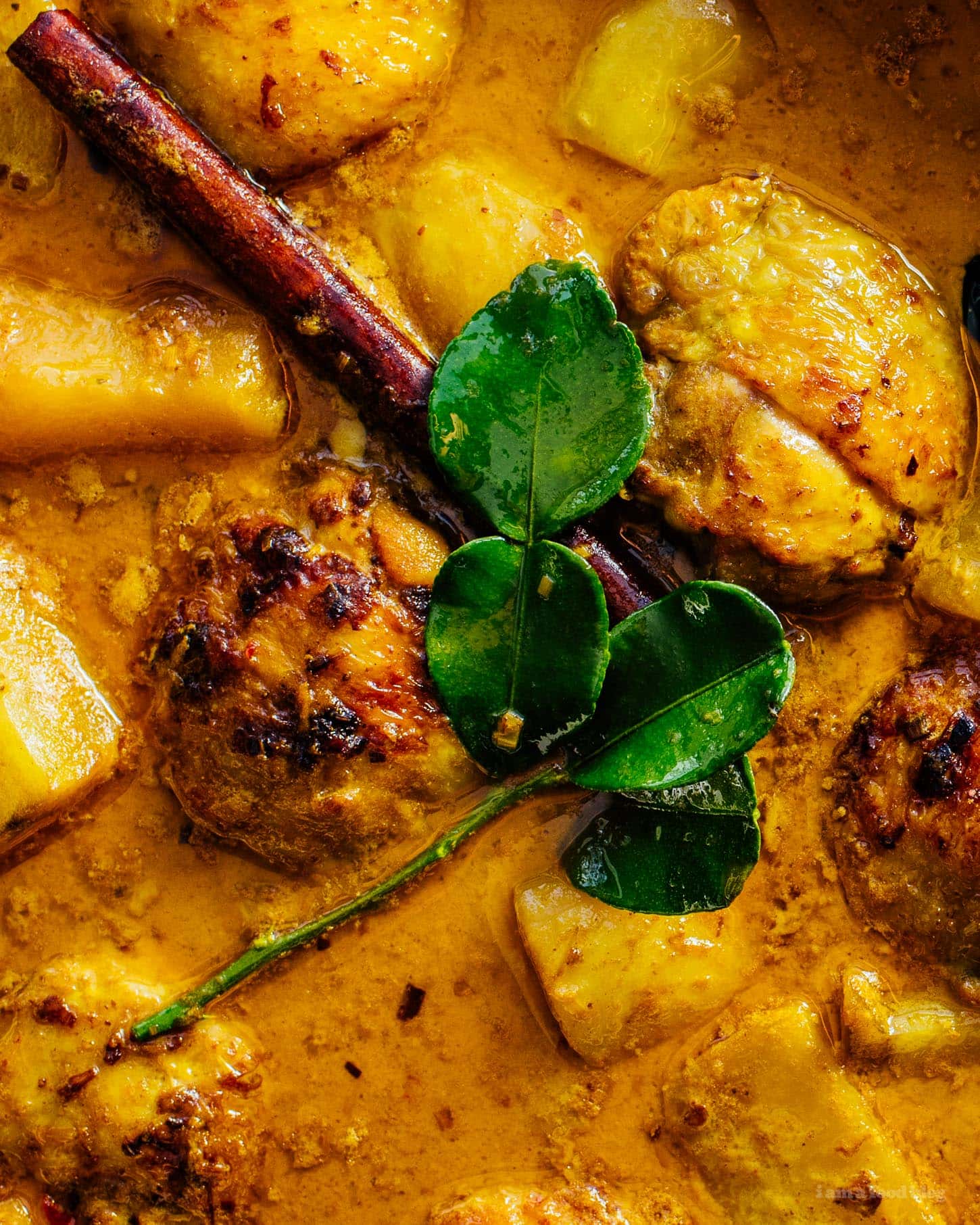Coconut Chicken Curry is one of my all-time favorite comfort foods, especially this version: Malaysian Coconut Curry Chicken. The tangy coconut curry sauce spooned over the rice is so, so good.
This is my ultimate chicken curry: savory and flavorful, with a hint of spice and a coconut base; tender, large, juicy pieces of chicken; soft and tender potatoes that still hold their shape; and a sauce thick enough to coat a spoon, but not so thick that it doesn’t spread easily over the rice.

This chicken curry recipe is the best of all worlds
This curry is a blend of Malaysian, Singaporean and Indonesian styles. It is thickened with coconut milk, seasoned with fish sauce and flavored with lemongrass, star anise and cinnamon. A delicious flavor bomb with just a hint of sweetness and spice.
It’s 100% a labor of love: hand-whipped aromatics, a custom blend of spices, and a gentle slow simmer, just long enough for the oils to separate and float to the top for those glorious pools of seasoned oil on top of the delicious but tender oil. thick. coconut curry sauce.
How to make coconut chicken curry
- Make the curry paste. Crush all the lemongrass, garlic, shallots, ginger and Thai chilies together with a mortar and pestle. You can also use a food processor. Mix in the curry powder, turmeric, chilies and a little oil.
- Marine. Let the chicken soak up ALL the flavors. Longer is better, but at least 30 minutes.
- Beat up. Give the skin of the chicken a nice golden brown. This also lightly browns the curry paste to bring out the flavors.
- Boil. Simmer everything together until the chicken is tender and cooked through and the potatoes are nice and tender, about 1 hour.


Chicken curry ingredients
It looks like you need a lot for this chicken curry, and I won’t lie, the ingredient list is on the long side, but it’s worth the shopping and time investment. Along with the standard chicken, potatoes, garlic, ginger, coconut milk, and chicken stock, you’ll need the following:
- lemon – These days you can find lemongrass paste in the grocery store, but the taste difference between cutting your own and buying it at the store is very different. It’s best topped with fresh lemongrass: just whip out your favorite knife and go to town.
- Shallots – Shallots will add a little extra sweetness and onion flavor without the onion. They are sweet and mild and are widely used in Southeast Asian food.
- Curry powder – Try to buy a Malaysian curry powder mix from an Asian grocery store, but if you can’t, regular curry powder will do.
- Turmeric – A little turmeric goes a long way. It’s wholesome, earthy and adds a sunny orange hue to the curry. Turmeric is an absolute must for curry.
- Cinnamon stick – A whole cinnamon stick adds some warmth and some sweetness.
- Star anise – Use whole anise when cooking the curry, the slight bitterness of the licorice really compliments all the other flavors.
- Fish sauce – Instead of salt, we will use fish sauce to taste them. It’s rich and full of umami and really enhances the flavors of the chicken.
OPTIONAL
- Thai chili – These little red peppers pack a punch. I like to add fresh chilies to curries because they bring some heat, but if you’re on the wrong side, you can leave them out or saute them.
- Crushed Chinese Chili Flakes – You can really use any crushed chili pepper, but Chinese crushed chili flakes have fewer seeds and are roasted in such a way that the smoke and flavor of the pepper really shines through.
- Lime leaves – These are optional because I know how hard it can be to find fresh lime leaves. If you can find them, they will add a slight citrus freshness.


The sign of a good curry
By the way, those puddles of oil on top are a sign of a very good curry, if you’re asking Malaysians or Singaporeans or Thais or Indians or anyone who knows curry.
You want your coconut milk and spices to separate into two: a flavor-packed oil and a rich, dense, coconut base. When your curry separates, it means that all the excess water that was in the coconut milk has evaporated and your curry is now concentrated, leaving only the flavorful good stuff.


Is this chicken curry spicy?
A good chicken curry is adaptable – you should be able to make it spicier if you’re a spice fiend, and a bit milder and sweeter if you’re looking for a light, comforting curry. If you don’t want it spicy, leaving out the fresh and dry chilies will make this a family-friendly affair.
Instant Pot Chicken Curry
To make Chicken Curry in the Instant Pot: Once the chicken is marinated, heat 2 tablespoons of oil in the Instant Pot insert on high. When the oil is hot, fry the chicken, skin side down, until golden. Turn the chicken skin side up and add the coconut milk, chicken stock, cinnamon stick, star anise and lime leaves. Cook on high pressure for 10 minutes. Remove quickly when the cooking time is up and reduce the stock to a high simmer if desired.
Pot Chicken Curry
To make one pot chicken curry: Once the chicken is marinated, heat 2 tablespoons of oil in a pan. When the oil is hot, fry the chicken, skin side down, until golden. Remove the chicken from the pan and add it to the slow cooker. Stir in the coconut milk, chicken broth, cinnamon stick, star anise, and lime leaves. Cook on low for 4 to 5 hours.
Curry powder
If you’re feeling ambitious, you can make your own curry powder at home. You will need:
- 2 tablespoons of coriander seeds
- 1 tablespoon cumin seeds
- 2 whole cloves
- 1 tablespoon of fennel seeds
- 1 teaspoon whole black pepper
- 2-inch cinnamon stick, broken into pieces
- 1 tablespoon crushed Chinese chilies
- 1-2 whole cardamom pods
- 5-6 dry Chinese chilies
- 3 tablespoons of ground turmeric
Toast all the spices without the turmeric in a dry pan over low heat, stirring occasionally, until fragrant. Let it cool completely and then grind it into powder. Stir in the turmeric. If you can find dried curry leaves, add them to the mixture when you grind everything into a powder.


What to serve with chicken curry
Sometimes I like to have some lime on the side to squeeze some freshness and serving cucumbers with this is a pro move, the fresh juicy crunch of a good cucumber plays well with the spice.
I hope you try this curry chicken. It is near and dear to my heart.
Chicken curry and roti prata forever!
xoxo steph


Coconut Chicken Curry
Slightly spicy, coconutty and comforting Malaysian curry chicken.
It serves 4
Curry paste
- 2 stem lemon slices
- 4 carnation garlic minced
- 2 shallots peeled and grated
- 1 tablespoon ginger minced
- 2 tablespoon curry powder Malaysia/SE Asian preferred
- 1/2 SPOON ground turmeric
- 1/2 SPOON red pepper flakes Chinese preferred
- 1 bird’s eye Thai chili slicesoptional (or more, you monster)
- 2 tablespoon oil
For Curry
- 2 tablespoon oil
- 8 chicken thighs bone-in, skin-in
- 3-4 potato small, peeled and cut into quarters
- 1 cinnamon stick
- 2 star anise pod
- 5 lime leaves optionally
- 1.5 CUPS coconut milk
- 1/2 CUP chicken stock
- 1 tablespoon fish sauce
- 2 SPOON brown sugar
-
Grind the lemongrass, garlic, shallots, ginger and Thai chili in a mortar (or a food processor, but it will be less tasty) until it resembles a paste. Stir in the curry powder, turmeric, crushed chilies, and 2 tablespoons oil. Coat the chicken completely with the curry paste and leave to marinate for 30 minutes.
-
In a large Dutch oven, heat 2 more tablespoons of oil and fry the chicken, skin side down, until golden brown. Turn the chicken skin side up and add the potatoes. Stir in the coconut milk, chicken broth, cinnamon stick, star anise, and lime leaves.
-
Bring to a simmer and cook for 1 hour, or until the chicken is soft and tender. Season with fish sauce and brown sugar and enjoy!
Nutrition facts
Coconut Chicken Curry
Amount per service
Calories 809
Calories from fat 504
% Daily Value*
Fat 56 g86%
Saturated fat 26.6 g166%
cholesterol 114 mg38%
Sodium 569 mg25%
potassium 1369 mg39%
Carbohydrates 42.1 g14%
Fiber 7.5 g31%
Sugar 6.9 g8%
Protein 38.2 g76%
* Percent Daily Values are based on a 2000 calorie diet.




